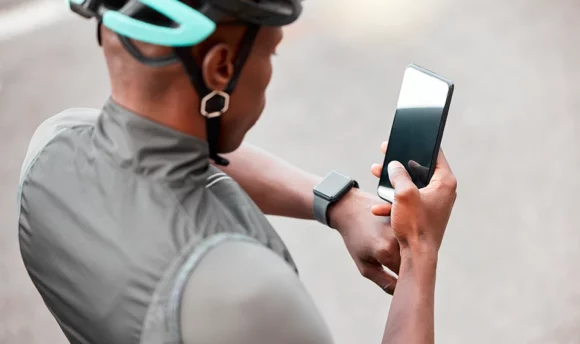How Many Calories Does Cycling Burn?
Struggling to lose weight? In this article, we will discuss the calorie-burning potential of cycling, as well as key changes you can make in order to get the most out of your cycling workouts.

If losing weight is one of your priorities, understanding which of your favorite exercises burn more calories will help you cater your workout plan to fit you best.
Cycling is a low-impact exercise that has many health benefits, including losing weight through high energy output and increasing your muscle tone.
Whether you decide to spend your time on a stationary bike or enjoy your day off mountain biking in nature, you really can’t go wrong.
There are many factors that affect the number of calories you burn while cycling.
Throughout this article, you will learn what these key differences are and some helpful ways for you to fine-tune your workouts, helping you see results faster.
How Many Calories Does Cycling Burn?
How many calories you can expect to burn while cycling will depend on your speed, body weight, and the kind of bike you ride. On average, 30 minutes of cycling can burn anywhere from 200 to 700 calories. An hour of cycling can earn you more than 450 calories burned.
Indoor Biking
Stationary bikes can be found at most gyms and are useful for getting in cycling workouts when it’s too cold to go outdoors.
When indoor cycling, you remain in one place. Instead of being challenged by biking up hills or across tricky terrain, you can adjust the resistance of your pedals. This allows you to cater your workouts to match your level of fitness and means that you can expect a consistent workout every time.
Although indoor cycling is a great workout, you can’t expect to burn as many calories or get as full of a workout as you would biking outdoors.
That being said, any kind of biking will improve your cardiovascular health. And during a 30-minute stationary bike workout, you can expect to see between 200–450 calories burned, depending on your weight and output.
Outdoor Biking
Biking outdoors is a fantastic workout and can be added to your daily commute or done as a way to get out into nature.
Although riding a stationary bike works mostly on your hamstrings, biking outdoors involves more of the muscles in your lower body. This includes your glutes, quads, calves, and even the muscles around your shins.
If your chosen bike path includes a lot of hills, however steep, you can also expect to work your arms and your core as you exert extra strain to make it to the top.
Since biking outdoors involves the use of more of your muscles, it also increases the number of calories burned during your ride. The amount of calories burned during a 30-minute outdoor bike ride ranges anywhere from 240 to 700.
How to Improve Your Calorie Burn While Biking
Do you feel like you’re not getting results? The following are some of the changes you can make to help you increase the number of calories burned while biking.
Choose a different cycling terrain
The best way for you to burn calories while you cycle outdoors is to ride more challenging terrain.
Riding a bike uphill is a full-body workout. It works your lower body, core, and even your arms, and for this reason, it is one of the best ways for you to burn more calories. During a 30-minute uphill bike ride, you can expect to burn close to 500 calories.
If figuring out ways to trim minutes off your workout is a priority, try mountain biking up any big hills in your area for an intense, calorie-burning workout.
Try a cycling training plan
Consistency is the most important part of any weight loss journey.
If your workouts are feeling routine and invigorating, finding a training program could be just the push you need.
It’s important to mix up your training days, not only to challenge different muscles but also to keep your mind entertained while you exercise.
It’s hard to stay motivated when you are doing the same workout day in and day out.
Cycling.Diet is an app that can help you stay consistent by providing unique training programs for you to follow. There are also meal planning options included, created by nutrition experts.
Eating nutritious foods and finding a workout plan that works for you will help you start burning extra fat and get you one step closer to reaching your fitness goals.
Cycle with a backpack or weight vest
A weighted vest is a vest that contains small pockets for you to fill with either small bags of sand, weights, or any other weighted objects.
Cycling with extra weight increases the difficulty of your workout and can give you the edge you’re looking for.
Since your muscles have to work overtime supporting this extra weight and carrying it forward, it increases your energy expenditure. This results in more calories burned at the end of your workouts.
Increase the pedaling intensity
The difference between cycling for 30 minutes at a leisurely pace and a high-intensity pedal for the same amount of time is around 300 calories.
The best way for you to get the most out of your time spent on your bike is simply by cycling harder or faster.
This doesn’t necessarily mean you have to cycle at high-speed. Even 30 minutes of moderate cycling – meaning an average of around 13mph – can make a 100-calorie difference.
Little changes like these help you get that extra mile out of your workout.
Increase the biking distance
There are ways for you to still enjoy a leisurely bike ride while still staying consistent with your weight loss journey.
Simply increasing your time spent biking and the distance you cover will help you burn more calories without sacrificing enjoyment.
For every mile you bike, you can expect to burn around 50 calories. So depending on how many calories you are hoping to burn during your workout, you can choose a distance that works for you.
Why Is Cycling Worth It?
Still not sure whether cycling is right for you? These are some of the additional health benefits of biking:
Promotes muscle gain
Cycling does wonders for creating muscle growth and getting rid of pesky inner thigh fat.
It is one of the best workouts you can do to target the muscles of your lower body and will give you well-rounded muscle growth, helping you see improvements in your glutes, thighs, and calves.
Difficult cycling, like mountain biking, can cater to the growth of fast-twitch muscle fibers, which help your muscles produce short bursts of high output. This also means you can expect your muscles to be larger and bulkier than what you would expect if you were running long distances.
If you are concerned about having a bulky upper body, doing a lower-body-focused exercise like cycling could be the perfect fit for you.
Weight loss
Cycling is a great exercise for anyone looking to lose weight because of the number of calories it burns in a short period of time.
You can get into the habit of regular cycling by riding an indoor stationary bike during the colder months.
Come summer, break out your road bike for longer cycles or your mountain bike, which you can use for rockier terrain and include high incline hill climbs. You can expect to burn the most calories during outdoor cycling.
Because cycling is a low-impact exercise, it is also a great starting place for anyone who is currently overweight.
Start to lose weight and strengthen your bones and joints before you begin doing other high-impact exercises, such as running.
One of the best ways to travel
In addition to the various physical health benefits, cycling can also have a positive impact on other areas of your life.
Choosing to swap out your daily car or bus commute for a leisurely bike ride can have positive effects on your mental health, as well as your budget.
Combining your daily commute with cycling will allow you to start and end your day with physical exercise. You can skip out on being stuck in congested traffic and give your day some magic as you listen to music and cruise through the streets of your city.
Even on your days off, opt to leave your car at home and take your bike instead. It might take some getting used to in the beginning, but once you’ve figured out a way to make your bike adventures seamless, you’ll never want to go back.
Helps you build a better community
Doing any new activity will give you the opportunity to meet like-minded people with goals that are similar to yours.
Even if you already have a solid group of friends, it’s possible that the way they spend their time isn’t in alignment with yours.
You might want to do more outdoor activities or just generally focus more on your own self-improvement. If this is the case, being surrounded by people who would rather hit the club than the gym won’t help you reach your goals.
Start offering other opportunities to connect with your friends. Propose going for a leisurely cycle around your city on a Saturday morning instead of your usual brunch with mimosas. It could be that your friends are also interested in switching up their habits.
If not, then there’s nothing wrong with branching out and trying to find friends whose interests are more in alignment with yours.
You could start scouring Facebook groups in your area that are dedicated to cycling or go to a local cycling event. Although you might need to step outside of your comfort zone at first, having a long list of friends you can message to go for a ride with will be well worth it in the long run.
FAQs
By cycling for one mile at a leisurely pace, you can expect to burn around 60 calories.
The average person will burn between 450 and 750 calories per hour on a bike. This number can be heightened or lowered by adjusting your speed or incline.
The number of calories you can expect to burn during a 30-minute bike ride will change depending on your weight, speed, and incline. On average, you can expect to burn between 300 and 600 calories.
A Word From Our Coach
Between the cardiovascular benefits, possible muscle growth, and enjoyment factor of cycling, there are so many reasons for you to include cycling as a part of your daily commute or weekly exercise routine.
Although it’s important to be mindful of the number of calories you consume and burn per day, burning calories and losing weight is just an added bonus of cycling.
The more intentional you are about keeping your workouts fun and finding ways to bring more enjoyment into your diet and exercise plan, the easier it will be to stay consistent.
Continue focusing on making shifts that can not only be seen but also felt, and it will be easier than ever for you to accomplish all of your fitness goals.
Bottom Line
Regardless of how you choose to work cycling into your life, the benefits are undeniable.
Buying a low-cost, used bicycle for you to use for your daily commute is the most accessible way for you to begin cycling.
It is also what will help you see the best results because consistency is key, and outdoor biking is an overall better exercise.
But even opting to spend more time at the gym on a stationary bike or buying one to use at home is also a great option.
Either way, you can expect to start burning calories fast, and burning more calories in combination with eating a healthier diet is the best way to lose weight and keep it off.

















































 Select your language:
Select your language: 








